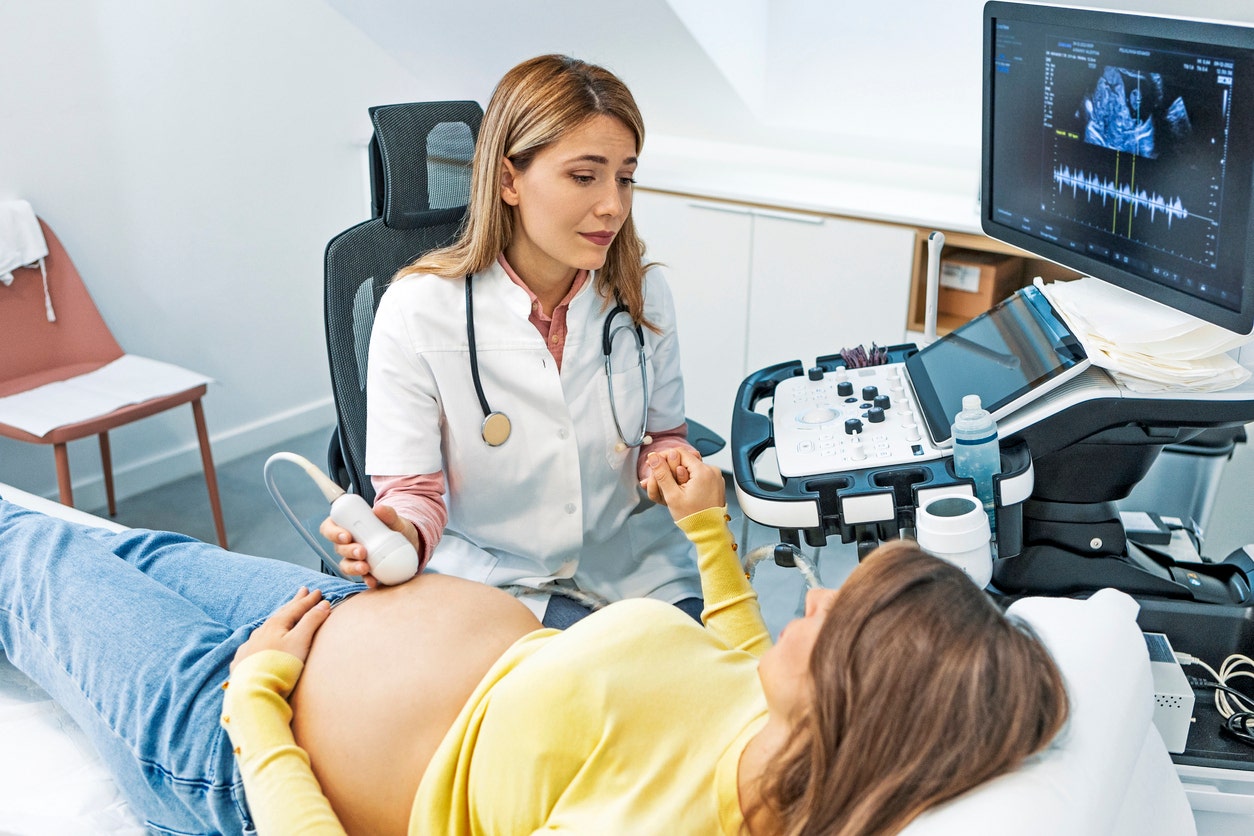Health
AI may have an ‘eye’ on growing babies: Could predict premature birth as early as 31 weeks

About 10% of all infants born in the U.S. in 2021 were preterm — which means they were delivered earlier than 37 weeks of pregnancy, per the Centers for Disease Control and Prevention (CDC).
Preterm births also make up about 16% of infant deaths.
Now, researchers from Washington University in St. Louis, Missouri, are looking to improve those odds through the use of artificial intelligence.
They developed a deep learning model that can predict preterm births by analyzing electrical activity in the woman’s uterus during pregnancy — then they tested the model in a study that was published in the medical journal PLOS One.
AI TOOL HELPS DOCTORS MAKE SENSE OF CHAOTIC PATIENT DATA AND IDENTIFY DISEASES: ‘MORE MEANINGFUL’ INTERACTION
“The key takeaway is that it is possible to take data as early as the 31st week and predict preterm birth up to the 37th week” — which surprised the researchers, Arye Nehorai, PhD, professor of electrical engineering at Washington University in St. Louis, told Fox News Digital.
Researchers from Washington University in St. Louis, Missouri, have developed a deep learning model (not shown) that can predict preterm births by analyzing electrical activity in a woman’s uterus during pregnancy. (iStock)
“The AI/deep learning automatically learned the most informative features from the data that are relevant to the prediction of preterm birth,” he added.
Additionally, the findings indicate that preterm birth is an abnormal physiological condition, not just a pregnancy that happened to end early, Nehorai said.
During the study, the researchers performed electrohysterograms (EHGs), which use electrodes on the abdomen to record electrical activity in the uterus.
They took recordings of these electrical currents from 159 pregnant women who were at least 26 weeks along and “trained” the AI model on that data.
RUPTURED BRAIN ANEURYSM LANDS SOCIAL MEDIA INFLUENCER IN MEDICALLY INDUCED COMA AFTER EMERGENCY C-SECTION
They combined this data with medical information such as the woman’s age and weight, the fetal weight and any bleeding experienced in the first or second trimester.
Nearly 19% of the women in the study delivered preterm. In theory, the data from those women could be used as a benchmark for predicting premature birth.

About 10% of all infants born in the U.S. in 2021 were preterm, which means they were delivered earlier than 37 weeks of pregnancy, per the CDC. (iStock)
“The advantage of our approach is that is inexpensive to build,” said Nehorai of the new research. “Our model was effective in prediction with shorter EHG recordings, which could make the model easier to use, more cost-effective in a clinical setting and possibly usable in a home setting.”
Looking ahead, the researchers believe that this method should be adopted by hospitals and obstetricians as part of women’s regular pregnancy check-ups. It would then allow pregnant women to seek care and make lifestyle changes to protect the health of their baby as needed.
“Our work contributes to the goal of using EHG measuring devices for accurately predicting preterm birth.”
“A device dedicated to implementing our method should be built for this purpose,” said Nehorai.
It is hard to say how long it might be before this kind of test becomes widely available, the researchers said.
“There are some EHG measuring devices already in the market — however, it has been challenging to predict preterm births from the EHG data,” said Uri Goldsztejn, a PhD candidate in the department of biomedical engineering working under the supervision of Professor Nehorai at Washington University.
NEW AI ‘CANCER CHATBOT’ PROVIDES PATIENTS AND FAMILIES WITH 24/7 SUPPORT: ‘EMPATHETIC APPROACH’
“Our work contributes to the goal of using EHG measuring devices for accurately predicting preterm birth,” he told Fox News Digital.
EHG measurements usually take between 30 and 60 minutes, with additional time required for setting the device on the mother’s abdomen, noted Goldsztejn.
“We showed that predictions could be made based on shorter EHG measurements, of under five minutes, without reducing the prediction accuracy too much,” he told Fox News Digital. “This finding is significant, since the prolonged duration of EHG measurements is an important limitation for its adoption in clinical settings.”
‘Promise’ of deep learning — but caveats
Dr. Suzy Lipinski, a board-certified OB/GYN at Pediatrix Medical Group in Denver, Colorado, was not involved in the study but shared her input on whether the deep learning technology could help solve the problem of preterm birth in the U.S.
“Being able to predict who is at risk before they present in labor would be highly beneficial,” Lipinski told Fox News Digital. “The use of a deep learning model seems to hold promise; however, this study has a relatively small number of patients, so it cannot be determined how applicable this is to a larger population.”

“Being able to predict who is at risk before they present in labor would be highly beneficial,” one obstetrician told Fox News Digital. (iStock)
“Prior studies using AI have not shown great reliability, so this will need more studies and larger patient populations before we start using this method,” she added.
Another potential limitation is that very few places use EHG measurements, the doctor pointed out.
“The standard in most hospitals and offices is to use a tocodynamometer, which measures pressure, not electrical,” she explained.
OZEMPIC, WEGOVY AND PREGNANCY RISK: WHAT YOU NEED TO KNOW ABOUT THE ISSUE
If EHG becomes the way to evaluate for preterm birth, then hospitals, birth centers and offices would all have to purchase new equipment, which could delay adoption in low-resource areas such as rural and inner cities, Lipinski said.
“A higher rate of preterm birth in this study than the national average also raises questions about the applicability,” she told Fox News Digital. “No demographics were given about the patient population, so there is no way to see how it reflects the population of the entire country.”
“Being able to predict who is at risk before they present in labor would be highly beneficial.”
There is also the chance of false positives, Lipinski pointed out.
“While this method does predict better than our current methods, there are still many patients that will be identified as at-risk that may not have a preterm birth,” she said. “This false positive result will cause a large burden of stress on the patient, as well as increased utilization of health care resources.”
If and when this becomes the new standard of care, Lipinski said, there would need to be improved treatments for preterm labor.
“Our issues with preterm birth are two-fold: We have poor prediction, but also poor prevention options after 26 weeks,” she added.
Researchers share study’s main limitations
The study has two main limitations, according to Goldsztejn.
“First, we developed our work using around 160 samples from two public datasets,” he said. “Although this amount of data was sufficient for our initial investigation, a far larger dataset would be required for developing and validating a medical product.”

The study findings indicate that preterm birth is an abnormal physiological condition, not just a pregnancy that happened to end early, the lead researcher said. (iStock)
The second limitation comes from the nature of deep learning, which can produce accurate results but is usually hard to interpret, Goldsztejn said.
“In other words, it is challenging to understand how the algorithm makes predictions,” he explained.
CLICK HERE TO SIGN UP FOR OUR HEALTH NEWSLETTER
In a discussion of the findings in the medical journal, the authors noted that “although machine learning algorithms can contribute to improving health care and much research is yielding advances in this field, important challenges remain.”
“A far larger dataset would be required for developing and validating a medical product.”
Among those challenges: It can be difficult to identify the causes behind the algorithm’s predictions, the researchers wrote.
“In our case, although our predictions could influence pregnancy management, our predictions would need to be supplemented with additional medical examinations to determine which therapies are more likely to reduce the risk of preterm birth and improve its outcomes,” the researchers also said.

Health
Semaglutide Pills and Injections Vs. Drops: Experts Weigh In | Woman's World

Sign Up
Create a free account to access exclusive content, play games, solve puzzles, test your pop-culture knowledge and receive special offers.
Already have an account? Login
Use left and right arrow keys to navigate between menu items.
Use escape to exit the menu.
Health
Jennifer Hudson Lost 80-Lbs Without Depriving Herself—Learn Her Secrets

Sign Up
Create a free account to access exclusive content, play games, solve puzzles, test your pop-culture knowledge and receive special offers.
Already have an account? Login
Use left and right arrow keys to navigate between menu items.
Use escape to exit the menu.
Health
Kennedy’s Plan for the Drug Crisis: A Network of ‘Healing Farms’

Though Mr. Kennedy’s embrace of recovery farms may be novel, the concept stretches back almost a century. In 1935, the government opened the United States Narcotic Farm in Lexington, Ky., to research and treat addiction. Over the years, residents included Chet Baker and William S. Burroughs (who portrayed the institution in his novel, “Junkie: Confessions of an Unredeemed Drug Addict”). The program had high relapse rates and was tainted by drug experiments on human subjects. By 1975, as local treatment centers began to proliferate around the country, the program closed.
In America, therapeutic communities for addiction treatment became popular in the 1960s and ’70s. Some, like Synanon, became notorious for cultlike, abusive environments. There are now perhaps 3,000 worldwide, researchers estimate, including one that Mr. Kennedy has also praised — San Patrignano, an Italian program whose centerpiece is a highly regarded bakery, staffed by residents.
“If we do go down the road of large government-funded therapeutic communities, I’d want to see some oversight to ensure they live up to modern standards,” said Dr. Sabet, who is now president of the Foundation for Drug Policy Solutions. “We should get rid of the false dichotomy, too, between these approaches and medications, since we know they can work together for some people.”
Should Mr. Kennedy be confirmed, his authority to establish healing farms would be uncertain. Building federal treatment farms in “depressed rural areas,” as he said in his documentary, presumably on public land, would hit political and legal roadblocks. Fully legalizing and taxing cannabis to pay for the farms would require congressional action.
In the concluding moments of the documentary, Mr. Kennedy invoked Carl Jung, the Swiss psychiatrist whose views on spirituality influenced Alcoholics Anonymous. Dr. Jung, he said, felt that “people who believed in God got better faster and that their recovery was more durable and enduring than people who didn’t.”
-
/cdn.vox-cdn.com/uploads/chorus_asset/file/25822586/STK169_ZUCKERBERG_MAGA_STKS491_CVIRGINIA_A.jpg)
/cdn.vox-cdn.com/uploads/chorus_asset/file/25822586/STK169_ZUCKERBERG_MAGA_STKS491_CVIRGINIA_A.jpg) Technology1 week ago
Technology1 week agoMeta is highlighting a splintering global approach to online speech
-

 Science1 week ago
Science1 week agoMetro will offer free rides in L.A. through Sunday due to fires
-
/cdn.vox-cdn.com/uploads/chorus_asset/file/23935558/acastro_STK103__01.jpg)
/cdn.vox-cdn.com/uploads/chorus_asset/file/23935558/acastro_STK103__01.jpg) Technology1 week ago
Technology1 week agoAmazon Prime will shut down its clothing try-on program
-

 News1 week ago
News1 week agoMapping the Damage From the Palisades Fire
-
/cdn.vox-cdn.com/uploads/chorus_asset/file/25826211/lorealcellbioprint.jpg)
/cdn.vox-cdn.com/uploads/chorus_asset/file/25826211/lorealcellbioprint.jpg) Technology7 days ago
Technology7 days agoL’Oréal’s new skincare gadget told me I should try retinol
-
/cdn.vox-cdn.com/uploads/chorus_asset/file/25832751/2192581677.jpg)
/cdn.vox-cdn.com/uploads/chorus_asset/file/25832751/2192581677.jpg) Technology4 days ago
Technology4 days agoSuper Bowl LIX will stream for free on Tubi
-

 Business5 days ago
Business5 days agoWhy TikTok Users Are Downloading ‘Red Note,’ the Chinese App
-
/cdn.vox-cdn.com/uploads/chorus_asset/file/25835602/Switch_DonkeyKongCountryReturnsHD_scrn_19.png)
/cdn.vox-cdn.com/uploads/chorus_asset/file/25835602/Switch_DonkeyKongCountryReturnsHD_scrn_19.png) Technology2 days ago
Technology2 days agoNintendo omits original Donkey Kong Country Returns team from the remaster’s credits

















